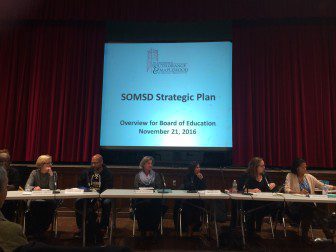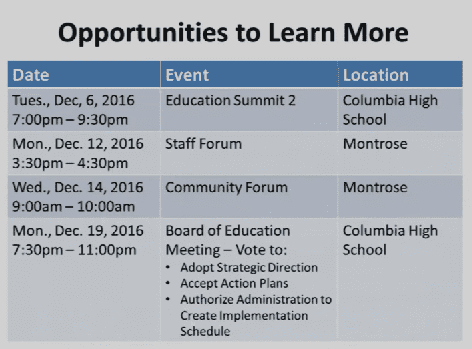After more than 12 months, the nine Action Planning Teams of the South Orange-Maplewood School District Strategic Plan process presented their ideas to the Board of Education on Monday night.
Some ideas (called “deliverables”) were very cerebral or esoteric — such as those involving curriculum or professional development. Others were very dynamic and easily relatable to the general audience — such as creating an internship program for high school seniors or extending Powerschool from K-12.
Some deliverables were very detailed; others were vague, with details to come in breakout groups at the December 6 Education Summit.
But overall there was a feeling of excitement in the auditorium at Columbia High School as the parents, teachers, administrators and students who participated in the Action Planning Teams presented their ideas.
“There is a lot of excellence in the district,” said one teacher from Strategy 4: Professional Development. Karen Weiland, who chaired Strategy 2: Multiple Student Supports, spoke of the enthusiasm of her team and others: “We are very passionate We are a small little army” ready to get to work. A team member from Strategy 1: Curriculum, Instruction & Assessment, hinted at how the teams were thinking outside of the box but not throwing the good away with the bad: “We’re very sensitive to the notion that there is a lot going well in the math at the high school and a lot at stake.”
The nine Strategies are:
- Strategy 1: Curriculum, Instruction & Assessment
- Strategy 2: Multiple Student Supports
- Strategy 3: Student Engagement
- Strategy 4 Professional Development
- Strategy 5: Cultural Competency
- Strategy 6: Partnering with Families
- Strategy 7: Scheduling, Facilities and Academic Structures
- Strategy 8: Community
- Strategy 9: Communications
Some of the more easily explained and exciting ideas/deliverables:
- potentially changing the academic calendar to allow for intensive periods of study such as internships,
- expanding Powerschool from k-12,
- creating intramural sports in the middle schools,
- involving students in the assessment process,
- creating mentoring “families” for students that stay together across years of education,
- having teachers work together vertically to hand off content and competency levels for students from grade to grade,
- creating multiple pathways to graduation at the high school,
- building flexible classroom space,
- developing SOMA Experts in Action to bring professionals from all fiends into the schools to volunteer their service and lend their expertise, and
- creating a student-run community storehouse to collect, repurpose and recycle materials from across the community for the schools.
(Scroll down to see the Action Team’s presentation and the Strategic Plan.)
There were dozens more ideas, some of which — including those around curriculum and professional development — deserve more intensive discussion to describe and relate. Team members said some deliverables cost nothing, some were extensions of already successful programs, others would be totally new, and some would cost money. However, all teams were cognizant of budget constraints in creating their deliverables.
One of the team members from Strategy 8 (Community) noted that there was overlap in some of the deliverables across strategies and said that was a good thing: “We overlapped with almost every other strategy – to our minds it means that those things make sense to tackle.”
During Board discussion after the presentation, there was overwhelming support for adopting and doing further work on the deliverables, with a number of Board members stating that they would vote to accept the Action Plans and move the work forward at the next Board of Education meeting in December.
Board member Johanna Wright was the most critical member of the Board. Although she thanked the team members for their work, she said she was concerned that she did not hear more about arts and music, as well as liaisons between the school district and the towns. She was also concerned about costs and felt there was not enough time to absorb the information before holding an Education Summit on December 6.
Several members of the Board addressed Wright’s concerns in their comments. Board President Elizabeth Baker noted that the Board was actively “liaising” with the towns and leadership of both South Orange and Maplewood had been present at the presentation on Monday night. Others noted that the plan was not an end point but a step in the process.
Board member Donna Smith said she could “see there is more work to be done” but called the work a “good start.”
Beth Daugherty reiterated team members’ points about overlap in deliverables: “Overlap drives home that they are key areas.” Daugherty said that the “most challenging” step would be “prioritizing what to do first” and noted that she would be “listening from the audience” as her term on the Board ends in January.
Board President Elizabeth Baker said that “one question may be on a number of people’s minds,” wanting to explain that the facilities Strategy Team’s work did not supersede that of the Board’s Finance Facilities & Technology committee. Superintendent of Schools Dr. John Ramos agreed, saying, “Remembering that the challenge in this process from the outset was to think about how to best educate our children for a future we have yet to imagine, we have to know that the outcome is not going to speak to specifics such as ‘what do we do with the pool.’ There are going to be any number of issues to incorporate into district goals….”
Stephanie Lawson-Muhammad thanked Ramos. “You didn’t just come and hand us your plan but allowed us time and space to create our own.” Lawson-Muhammad also “strongly” recommended “that we videotape all of these sessions so that people can get a taste of all nine of these strategies.” (Later, District Director of Strategic Communications Suzanne Turner confirmed that all the breakout sessions for each team will be videotaped at the December 6 Education Summit.)
Board Student Rep Filip Saulean said he was “a skeptic” about the plan. “We need to be down to earth. If we think this is truly going to solve the issues at CHS and the district we are sorely mistaken.” He urged the Board not to “pat ourselves on the back.”
Turner responded to Saulean by noting that “the idea of the action plans was that they were one-year increments of work. You’re absolutely right we have to keep building on the bits.”
Finally, Tamara Steckler, co-chair of Strategy 2, pointed out that the plan was a “huge first step. It’s not going to solve every problem We have to come from a place of ‘yes’ or we are not going to solve these problems. If any of you want to know more we ‘re accessible.”
Next steps:



